Langthorne Hospital
Stonelea, 1 Langthorne Road, Leytonstone, E11 4NJ
Medical dates:
Medical character:
1930 - 1999
Chronic sick, geriatric
In 1840 the West Ham Union built a new workhouse on land acquired from the Stratford-Langthorne Abbey.
The Leyton workhouse opened in 1842. The
3-storey,T-shaped main block had lower wings to the rear, thus creating
two courtyards for the male and female inmates. The ground floor
of the building contained offices, a surgery and wards for infirm
inmates. On the first floor were quarters for the Master and the
Matron, and dormitories for the inmates. Lying-in wards were on
the second floor. The rear wing contained a dining-room and
storerooms, with a kitchen in the basement.
The building was enlarged in 1845 and, in 1864, an infirmary with 200
beds was built to the west of the workhouse.
The workhouse was enlarged again in 1883, 1897-8 and 1913.
In 1930 control of the workhouse passed to the West Ham Borough
Council, which renamed it the Central Home Public Assistance
Institution - a home for the chronically ill, aged and infirm.
By 1936 it had 1,800 beds.
During WW2 the Home became part of the Emergency
Medical Service, with 1,330 beds.
The Home joined the NHS in 1948 under the control of the Leytonstone
Hospital Group Hospital Management Committee, part of the North East
Metropolitan Regional Hospital Board. It was renamed the
Langthorne Hospital, specialising in geriatric care. It had 831
beds for the chronic sick and 475 beds for aged, non-sick
residents under Part III of the National
Assistance Act, 1948 (i.e. those who did not need medical care, but
had nowhere else to go). Its motto was 'fiat jucunda senectus' -
let there be the delights of old age.
In the first three years of its entry into the NHS, improvements began
on the Hospital facilities. Two ward blocks - Q. and R. - were
upgraded, and ward kitchens installed. Unnecessary walls around
E. and T. blocks were removed and lawn laid down. In 1949 a
number of the old buildings were demolished so that car parking could
be provided. The bakehouse was converted into a central kitchen
and T. block into the staff canteen and recreation room for
non-resident staff, opening on 1st December 1950. J.2 ward was
upgraded, as was the block for psychiatric patients, which was also
plastered and decorated. General improvement to the wards and
facilities continued throughout 1950 and 1951, and a number of walls
were removed and new lawns and gardens laid down. In 1951 a small
Out-Patients Department was established to provide physiotherapy and
occupational therapy for suitable patients, with a view to relieving
pressure on hospital beds.
In March 1952 control of the 'Wednesday Evening Club', which had
been inaugurated in 1948 for the benefit of aged and ambulant patients
and run by a number of voluntary helpers, was passed to the Welfare
Department of the West Ham County Borough Council.
By 1955 the Hospital had 757 beds, as well as 220 for the Part III
inmates. The non-resident staff canteen was transferred to the
Great Hall and the vacated premises adapted into a ward for mentally
deficient patients. The new ward - Martha Ward - opened in August
1955. Improvements were made to all the bathrooms of the Hospital.
The Queen Mother visited in 1957, when the Hospital had 714 beds.
In 1959 it had 682.
In April 1960 the Duchess of Kent opened a new wing for geriatric
patients. Part of a £44,000 upgrading scheme for the former
Mains East Wing, the 3-storey building had an L-shaped ward unit with
20 beds on each floor. The wards were divided into 5 separate
sections of 4 beds each. The Day Room had an open fire - a homely
amenity appreciated by the patients, which provided a focal point for
their community life.
The weekly cost of an in-patient in 1960 was £15 12s 2d
(£15.61), compared to £14 15s 5d (£14.77) in 1959 - a
rise of 5.7%.
In 1965 the Dowager Marchioness of Reading, Chairman of the Women's
Royal Voluntary Service (W.R.V.S.), opened a social centre - the first
to be set up in a geriatric hospital. Run by the W.R.V.S., the
Social Therapy Centre - a purpose-built bungalow in the centre of the
Hospital site - enabled patients to meet up with their relatives in a
non-hospital setting. Patients were collected and returned to
their wards by police cadets.
In 1966 there were 800 beds for long-term patients.
Following a major reorganisation of the NHS in 1974, the Hospital came
under the control of the West Roding District Health Authority, part of
the North East Thames Regional Health Authority.
In 1982, after another NHS reorganisation, it came under the
jurisdiction of the Waltham Forest District Health Authority.
In 1990 the Hospital had 152 beds. It finally closed in 1999.
| Present status (January 2008) The Grade II listed buildings remain. The rest of the site is partly for residential use and partly for the public Langthorne Park. |
|---|
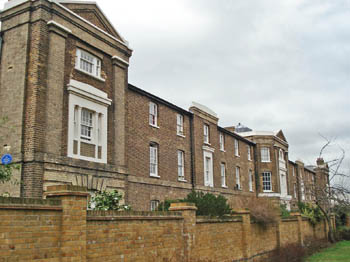
The original main block of the workhouse has been converted into housing.
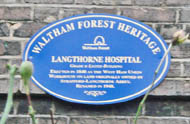
A commemorative
plaque to Langthorne Hospital on the side of the original workhouse
block above.
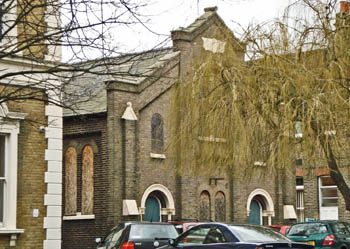
The chapel was built to the south of the workhouse in 1840. It has two doorways - one for men and the other for women. It is now Grade II listed.

The Board Room block to the west of the chapel was probably added around 1870.

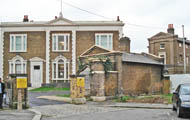
Mental health units in Thorne Close.
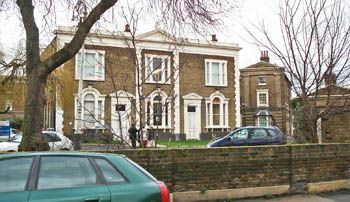
The original workhouse stores building to the east of the chapel is now part of the Thorne Centre.
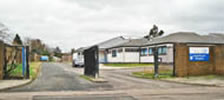
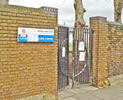
The Health Centre or 'Langthorne Hospital' from Langthorne Road (left). The entrance to the Health Centre (right).
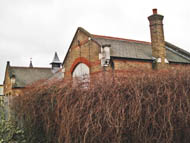
Maybe the old stable block in the Health Centre, from the back.
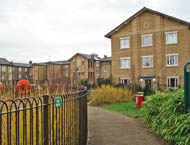
New housing on part of the Hospital site.
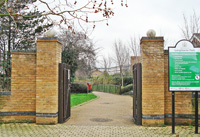
The entrance to Langthorne Park.
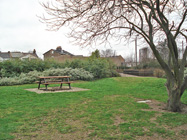

Langthorne Park.
Readers' comments
NORTH EAST THAMES REGION
EMERGENCY VOLUNTARY SERVICE
In the early 1980s Langthorne Hospital provided a set of three rooms -
restroom, kitchen and sleeping quarters - as well as a garage, for a
voluntary group established in 1981, called the EVS (Emergency Voluntary Service). The EVS operated a night-time delivery
service for the hospitals of northeast London, reaching out as far as
the Blood Bank in Brentwood and as far north as Chase Farm Hospital.
The group disbanded in 1998, when the Regional Health Authority reorganised their services.
"The EVS was, if I remember rightly, set up by two fellas called Terry Allen and Brian (can't remember his name for sure, may have been Toovey) after one of them discovered that the local Health Authority relied on non-emergency ambulances during the day and taxis at night for urgent deliveries. Not every hospital had path labs, so they would use taxis, which could cause delay in urgent situations. As a result, Terry and Brian offered their services at night, being called on radio pagers.
"The group grew, at which point they were offered a set of rooms in a quiet corner of Langthorne Hospital. I think it was Eddy Grimstead, the bike dealer, who donated a Honda CB400N motorbike complete with full livery and panniers. (Although his shop is still running, he died in 2013, but there may be someone still there who would remember it.)
"The group was very belt-and-braces at the beginning but, by the mid 1980s, had taken on a more professional appearance. I joined after they put an appeal for members out in a community slot on LWT one Friday night. We were grants a radio licence for walkie-talkie controlling, and were manning the station 24/7, 365 days a year, between 7 p.m. and 7 a.m. I myself remember being on the A102M one winter night thinking it was a bit cold, only to find out it was -8 C. Routine runs included path lab trips between St Andrew's Hospital and Newham General Hospital, nappy runs, blood runs from hospital to hospital and, occasionally, out to Brentwood to pick up blood packs. Pretty much anything a hospital wanted to be moved that would fit on a bike, we'd move, although sometimes staff at the hospitals would complain that we'd taken our time - they didn't realise that we were volunteers who weren't allowed to break speed limits or jump red lights - so, if traffic was heavy, we have to work hard to carve a path through it.
"All in all, it was a very positive thing, and an example of what can be achieved with a bit of community spirit. It also made a great social group and we'd run special events, like egg and toy runs to kids in local hospital at Easter and Christmas."
Julian Pilfold-Bagwell
References (Accessed 17th July 2019)
References (Accessed 27th August 2013)
(Author unstated) 1960 New geriatric wing,
Langthorne Hospital. British Medical Journal 2
(5212), 1612.
(Author unstated) 1965 News in brief. British Medical Journal
2 (5465), 830.
De Largy J 1967 Role of relatives in geriatric medicine. British
Medical Journal 2 (5545), 180.
http://collage.cityoflondon.gov.uk
http://exploringeastlondon.co.uk
www.britishlistedbuildings.co.uk (1)
www.britishlistedbuildings.co.uk (2)
www.flickr.com (1)
www.flickr.com (2)
www.flickr.com (3)
www.leytonhistorysociety.org.uk
www.londongardensonline.org.uk